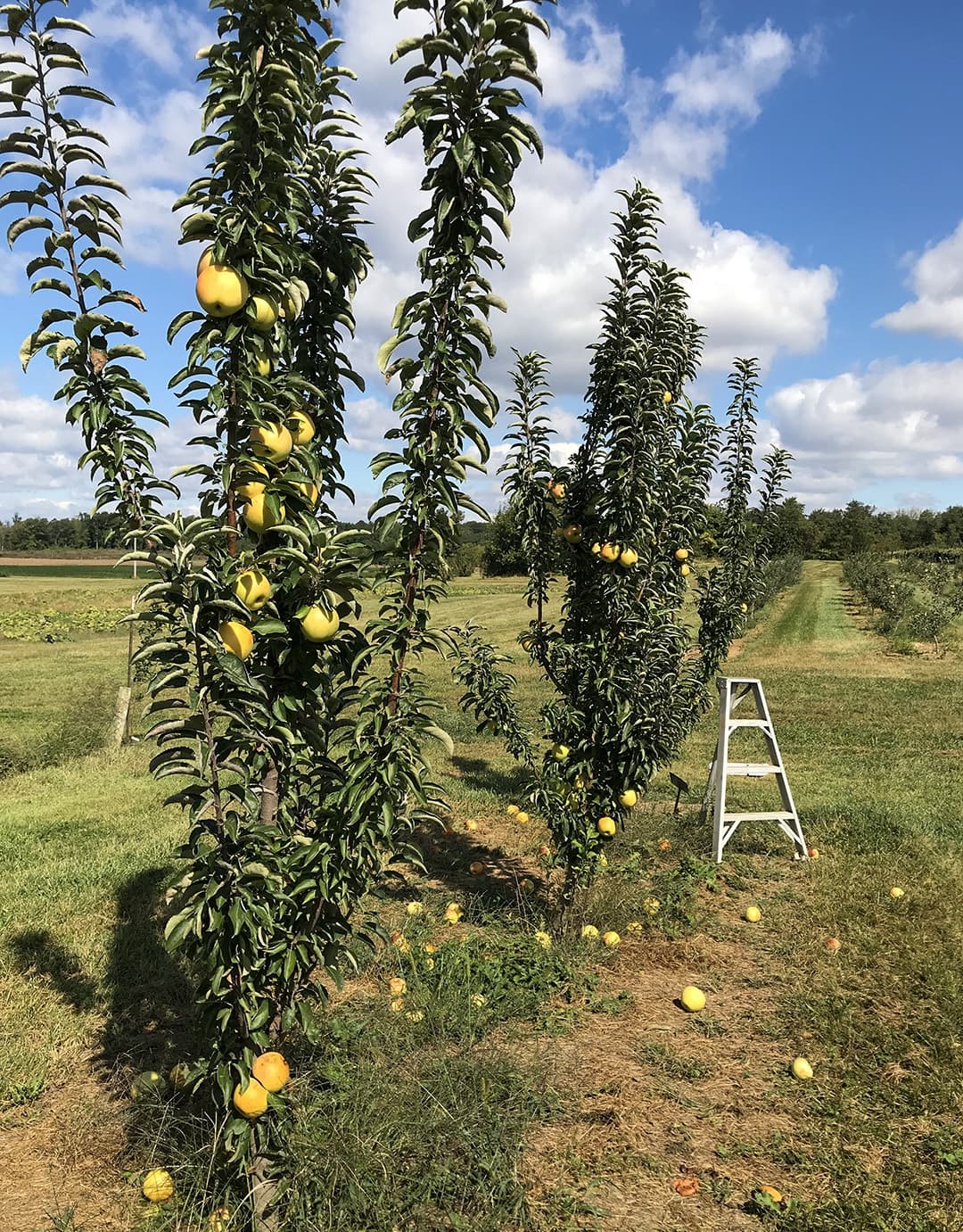By Kimbra Cutlip Apr 17, 2023
Here’s a crisp rejoinder to climate change: Through careful crossbreeding and selection, University of Maryland researchers have developed what may just be the perfect apples for American growers trying to adapt to a changing world.
The two new apples, a yellow and a red one, are heat-tolerant, blight-tolerant, low-maintenance, easy to harvest and not least, delicious-tasting. Both were recently approved for patents and are awaiting the final grant from the U.S. Patent Office.
They address a growing suite of problems for the apple industry. While the fruit has always been labor-intensive to bring to market, with trees that need to be trained, pruned and harvested by hand, apple farming has been among the hardest hit parts of the agriculture sector. According to USApple, the nonprofit apple industry association, labor shortages caused an average 3% drop in U.S. crop production employment annually from 2016 to 2021, but apple orchard employment plummeted by 22% a year. Meanwhile, the wages farmers must pay have risen at the same time the price of fresh apples has fallen.

Compounding these stressors on apple growers, the climate is changing rapidly: Heat waves in the Pacific Northwest in recent years strained the country’s largest apple-producing areas. The South is growing hotter, and northern and eastern regions of the country are seeing shorter and warmer cool seasons, all of which spell uncertainty for orchard fruits tuned to cooler conditions.
The UMD team’s new apple trees could help farmers sidestep these obstacles.
“These trees require a lot less hand labor compared to apples that are available to growers now,“ said Chris Walsh, professor emeritus in the Department of Plant Science and Landscape Architecture who developed the new apples with colleagues Julia Harshman and Kathleen Hunt. “We can’t say they’re non-pruning, but the pruning a farmer would do is minimal on these trees.”
These Maryland varieties grow into much shorter trees, which makes harvesting easier; they also appear tolerant to fire blight, a destructive bacterial disease common to apples. Heat tolerance is another important feature of these apples. It’s one of the earliest characteristics Walsh and his team bred into apples, and was a feature they introduced with the Antietam Blush apple in 2017. Specifically designed to grow in Maryland’s warm, humid climate, the Antietam Blush was the first University of Maryland apple released.
It sprang from the Tree Architecture Program that Walsh launched more than 30 years ago with the planting of some 5,000 apple seedling trees from eight commercial varieties at the Western Maryland Research and Education Center in Keedysville, Md. Now, the release of a yellow apple called MD-TAP1(which stands for Maryland Tree Architecture Program) and a red apple called MD-TAP2 stand to extend the program’s success even farther, because these apples feature a full suite of characteristics that make life easier for growers across the country.
Michigan State University and Texas A&M University scientists will conduct trials to see how well the apples grow in their climate conditions. The next step will be to license the apples to a commercial nursery that will produce the stock in large numbers and sell trees directly to growers. That nursery would most likely have the honor of coming up with a snazzy marketable name to replace MD-TAP1 and MD-TAP2.
When these apples make it to market, consumers are likely to see them in local fruit stands and farmers markets as well as pick-your-own farms.
The MD-TAP1 comes from a parent stock of apple marketed as GoldRush, and it looks and tastes a bit like a Golden Delicious. Its fruit ripens in late September. The MD-TAP2 is a child of Fuji apple stock, so it carries many of the same sweet flavor attributes. It ripens in October, perfect timing for the pick-your-own apple and pumpkin season.
“These apples were bred for direct-to-consumer sales,” Walsh said. “They’re not meant for the big chain stores to be shipped and stored for months. They’re meant to be eaten right off the tree.”
How apple growers are working to fight climate change
Battling Climate Change: University of Maryland researchers breed heat resistant apples
Have University of Md. researchers made the perfect apple for our region?
Abstract:
First-generation seedling apple trees derived from ‘McIntosh Wijcik’ (Malus × domestica Borkh.) were used as putative pollen parents to generate seed using ‘Cripps Pink’ and ‘Fuji’ as seed parents. Seeds from this open pollination were stratified, germinated, grown in the greenhouse, overwintered under cover and planted in the field. During their juvenile years, the seedling trees were sorted into two phenotypic categories: 1) trees exhibiting the wild-type phenotype typical of ‘Cripps Pink’ and ‘Fuji’, and 2) trees with an apparent columnar phenotype. Trees that had been identified with the ‘Wijcik-like’ phenotype were smaller than wild-type trees. Although they were smaller and yielded less fruit, they were found to be more efficient. No statistically significant interactions of cultivar and phenotype were noted for either tree size or efficiency. This research demonstrates that significant scion-dwarfing can occur in ‘Wijcik-type’ trees with enhanced yield efficiency. Harvest date, size and length-todiameter ratio were similar for fruit of both tree phenotypes and for both cultivars. Fruits from wild-type seedling trees were firmer, with higher soluble solids concentration (SSC) and a lower starch index than fruits from ‘Wijcik-type’ apple seedling trees. Apple scions with the greater height-to-spread ratio found in the ‘Wijcik-type’ phenotype could be applicable to the tall-spindle production system currently in vogue in North America. One of the major expenses to growers - labor - could be reduced significantly with the eventual development of scion varieties that are more efficient and naturally develop a more desirable architecture.
Volume 67 Number 3 Article 5 Pages: 168-174